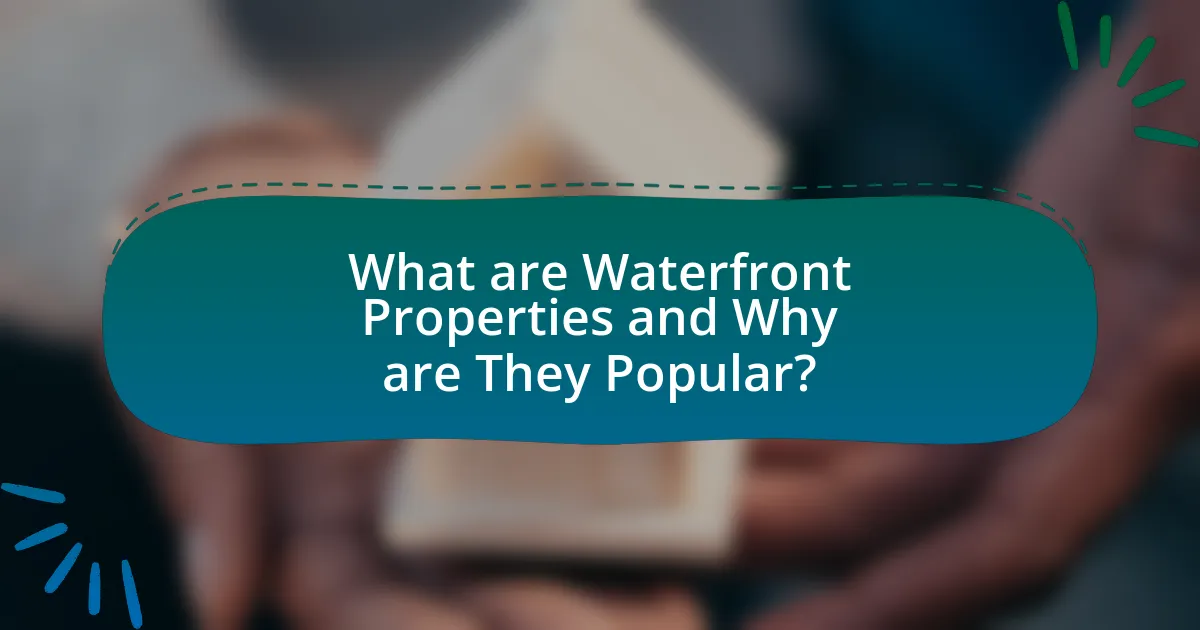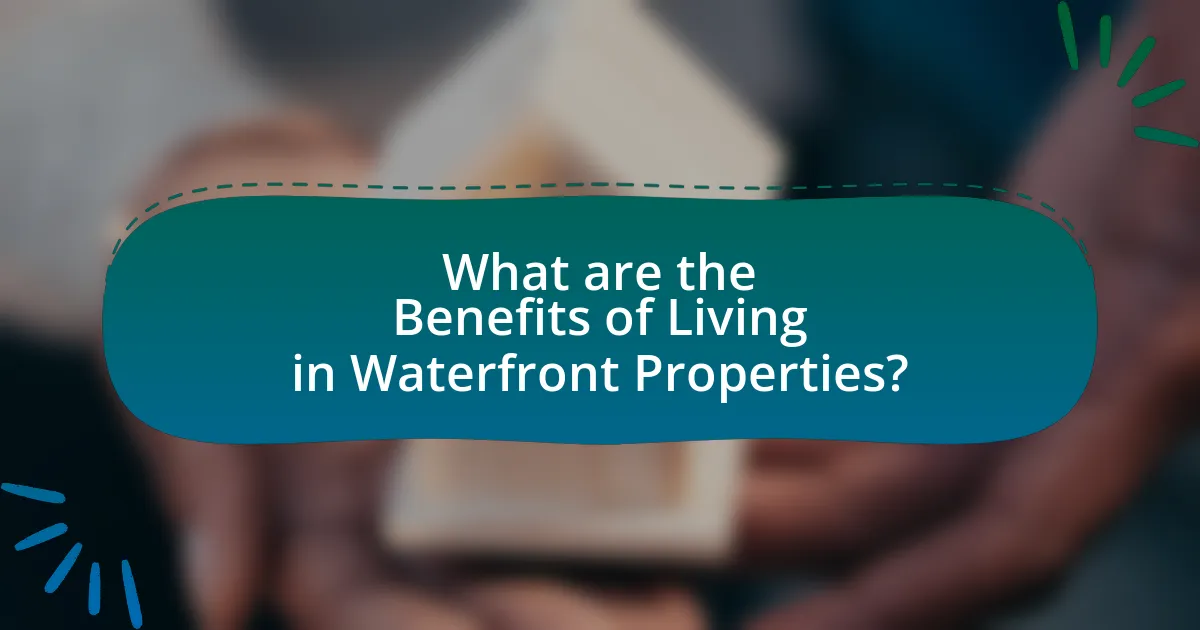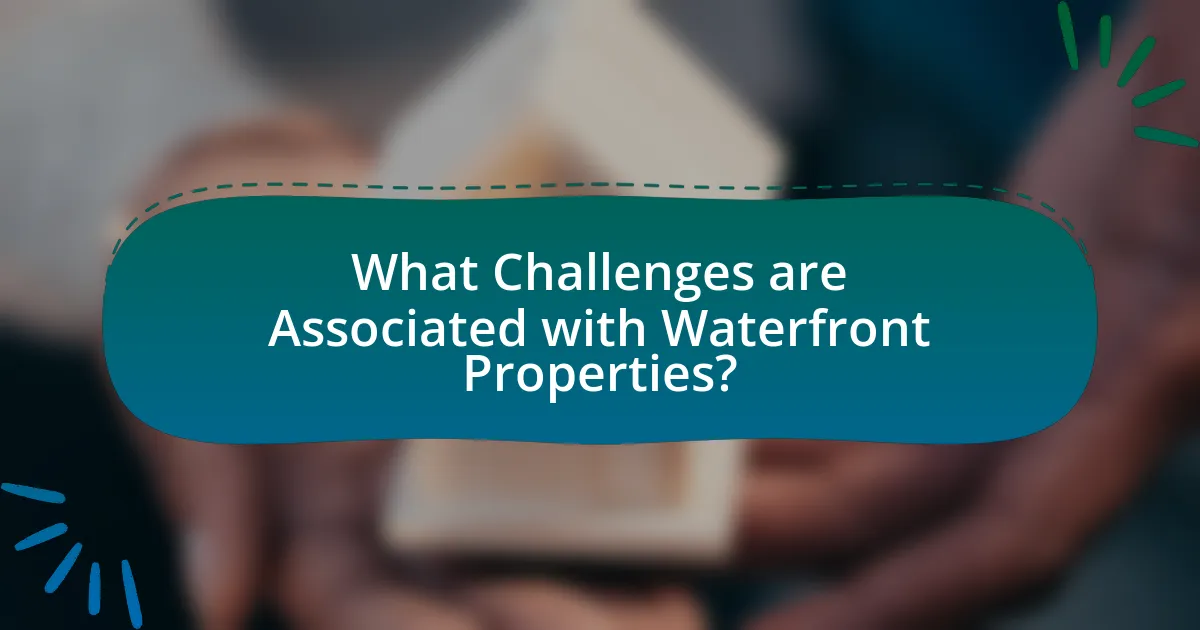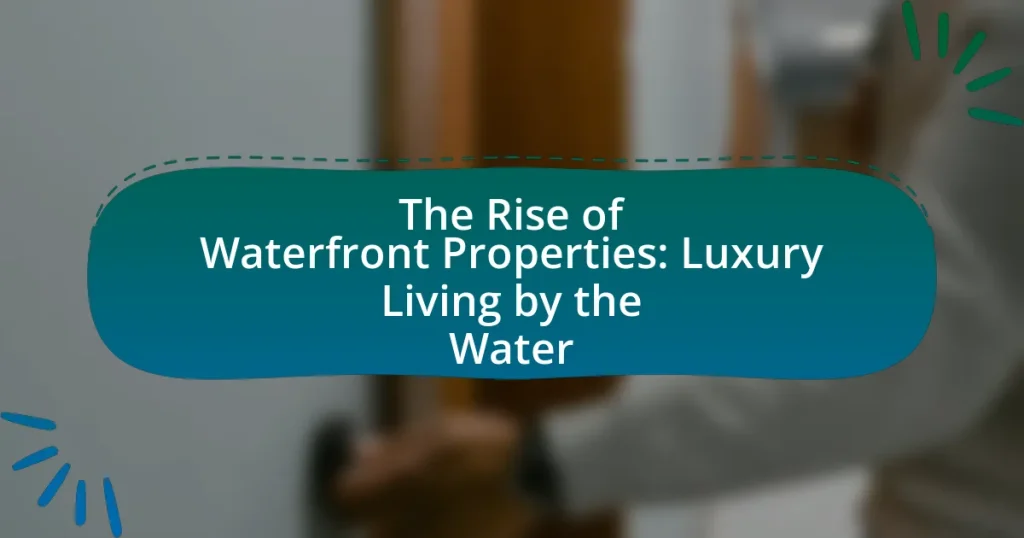Waterfront properties, defined as real estate developments adjacent to lakes, rivers, or oceans, have gained significant popularity due to their aesthetic appeal, recreational opportunities, and potential for higher property values. These properties often sell for 20% to 30% more than similar inland homes, driven by demand for leisure activities and the luxurious lifestyle associated with water access. The article explores the various types of waterfront properties, their unique benefits, and the increasing demand influenced by lifestyle trends, economic factors, and the impact of climate change. Additionally, it addresses the challenges and maintenance issues faced by waterfront property owners, providing essential insights for potential buyers considering investment in this lucrative market.

What are Waterfront Properties and Why are They Popular?
Waterfront properties are real estate developments located adjacent to bodies of water, such as lakes, rivers, or oceans. Their popularity stems from the aesthetic appeal, recreational opportunities, and potential for higher property values associated with water views and access. According to the National Association of Realtors, waterfront properties often command a premium price, with some studies indicating that homes near water can sell for 20% to 30% more than similar homes further inland. This demand is driven by the desire for leisure activities, scenic environments, and the perception of a luxurious lifestyle.
How do Waterfront Properties differ from other real estate options?
Waterfront properties differ from other real estate options primarily due to their unique location and associated lifestyle benefits. These properties offer direct access to water bodies, which enhances recreational opportunities such as boating, fishing, and swimming, making them highly desirable. Additionally, waterfront properties often command higher market values; for instance, a study by the National Association of Realtors indicates that homes near water can sell for 20% to 30% more than similar homes located inland. This premium is attributed to the scenic views, tranquility, and the prestige associated with living by the water.
What types of waterfront properties are available?
Various types of waterfront properties are available, including beachfront homes, lakefront cabins, riverfront estates, and marina slips. Beachfront homes offer direct access to the ocean, often featuring expansive views and recreational opportunities. Lakefront cabins provide a serene environment for relaxation and water activities, while riverfront estates typically offer scenic views and fishing opportunities. Marina slips cater to boat owners, providing docking facilities for watercraft. Each type of waterfront property caters to different lifestyles and preferences, reflecting the growing demand for luxury living by the water.
What features make waterfront properties desirable?
Waterfront properties are desirable primarily due to their scenic views, access to recreational activities, and potential for higher property values. The picturesque landscapes offered by waterfront locations enhance the aesthetic appeal, making them attractive for both living and investment. Additionally, proximity to water bodies allows for various recreational opportunities such as boating, fishing, and swimming, which are highly sought after by buyers. Furthermore, studies indicate that waterfront properties often appreciate faster than inland properties, with some reports showing a price premium of up to 50% for waterfront homes compared to similar inland homes, reinforcing their desirability in the real estate market.
Why has the demand for waterfront properties increased?
The demand for waterfront properties has increased due to a growing preference for lifestyle and recreational opportunities associated with water access. This trend is driven by factors such as the desire for scenic views, outdoor activities like boating and fishing, and the perceived value of living near water, which often enhances quality of life. According to a 2021 report by the National Association of Realtors, waterfront properties have consistently shown higher appreciation rates compared to non-waterfront homes, indicating strong market demand. Additionally, the COVID-19 pandemic has accelerated interest in spacious, nature-oriented living environments, further boosting the appeal of waterfront locations.
What economic factors contribute to the rise in popularity?
The economic factors contributing to the rise in popularity of waterfront properties include increased disposable income, urbanization trends, and low-interest rates. As disposable income rises, individuals are more willing to invest in luxury real estate, particularly in desirable locations like waterfronts. Urbanization drives demand for properties that offer both lifestyle and investment opportunities, as more people move to cities seeking proximity to amenities and leisure activities. Additionally, low-interest rates make financing more accessible, encouraging buyers to purchase high-value properties. According to the National Association of Realtors, waterfront properties have consistently shown higher appreciation rates compared to non-waterfront properties, reinforcing their appeal as a sound investment.
How do lifestyle trends influence the demand for waterfront living?
Lifestyle trends significantly increase the demand for waterfront living by prioritizing outdoor activities, wellness, and a connection to nature. As urban populations grow, individuals increasingly seek environments that offer recreational opportunities, such as boating, fishing, and beach access, which waterfront properties provide. According to a 2021 report by the National Association of Realtors, properties near water are often perceived as more desirable, leading to higher property values and quicker sales. This trend is further supported by the rise in remote work, allowing people to relocate to scenic areas without sacrificing employment, thus driving demand for waterfront homes.

What are the Benefits of Living in Waterfront Properties?
Living in waterfront properties offers numerous benefits, including stunning views, recreational opportunities, and increased property value. The picturesque scenery provided by waterfront locations enhances the quality of life, promoting relaxation and mental well-being. Access to water-based activities such as boating, fishing, and swimming fosters an active lifestyle and community engagement. Additionally, waterfront properties often appreciate in value due to their desirable locations, making them a sound investment. According to the National Association of Realtors, waterfront homes typically sell for 20% more than comparable inland properties, underscoring their financial advantages.
How do waterfront properties enhance quality of life?
Waterfront properties enhance quality of life by providing access to natural beauty, recreational opportunities, and a tranquil environment. Living near water has been shown to reduce stress and promote mental well-being, as studies indicate that proximity to water can lead to lower levels of anxiety and depression. Additionally, waterfront locations often offer activities such as boating, fishing, and swimming, which contribute to a more active lifestyle. The scenic views associated with waterfront living can also increase property values, making these locations not only desirable for personal enjoyment but also as sound financial investments.
What recreational activities are available to waterfront residents?
Waterfront residents have access to a variety of recreational activities, including boating, fishing, swimming, kayaking, and paddleboarding. These activities are facilitated by the proximity to water bodies, which provide ideal conditions for such pursuits. For instance, studies show that waterfront properties often enhance lifestyle options, allowing residents to engage in outdoor sports and leisure activities that promote physical health and well-being. Additionally, many waterfront communities offer amenities like marinas, private docks, and waterfront parks, further supporting these recreational opportunities.
How does waterfront living impact mental health and well-being?
Waterfront living positively impacts mental health and well-being by providing access to natural environments, which are associated with reduced stress and improved mood. Studies indicate that proximity to water can enhance feelings of relaxation and tranquility, contributing to lower levels of anxiety and depression. For instance, research published in the journal “Environmental Science & Technology” found that individuals living near water bodies reported higher life satisfaction and lower psychological distress compared to those in urban settings without such access. This connection to nature fosters a sense of community and encourages outdoor activities, further promoting physical health and social interaction, which are essential for overall well-being.
What financial advantages do waterfront properties offer?
Waterfront properties offer significant financial advantages, including higher resale values and rental income potential. Properties located near water bodies typically appreciate faster than inland properties, with studies indicating that waterfront homes can sell for 50% more than comparable non-waterfront homes. Additionally, the demand for vacation rentals in waterfront areas often leads to higher rental rates, providing owners with a lucrative income stream. This combination of appreciation and rental income makes waterfront properties a sound investment choice.
How do waterfront properties appreciate in value over time?
Waterfront properties appreciate in value over time primarily due to their limited availability and high demand. The scarcity of land adjacent to water bodies creates a competitive market, driving prices upward. Historical data shows that waterfront properties often appreciate at a rate significantly higher than non-waterfront properties; for instance, a study by the National Association of Realtors indicated that waterfront homes appreciated by an average of 20% more than inland homes over a decade. Additionally, factors such as desirable views, recreational opportunities, and lifestyle appeal contribute to sustained interest and investment in these properties, further enhancing their value over time.
What are the potential rental income opportunities for waterfront properties?
Waterfront properties offer significant rental income opportunities due to their desirable locations and unique amenities. These properties often attract vacationers and long-term renters seeking scenic views, recreational activities, and proximity to water-based attractions. According to a report by the National Association of Realtors, waterfront homes can command rental prices that are 20-30% higher than comparable inland properties, driven by demand for leisure and lifestyle experiences. Additionally, seasonal rentals in popular waterfront areas can yield high occupancy rates, particularly during peak tourist seasons, further enhancing income potential.

What Challenges are Associated with Waterfront Properties?
Waterfront properties face several challenges, including erosion, flooding, and regulatory restrictions. Erosion can lead to significant loss of land and property value, as coastal areas are particularly vulnerable to natural forces. Flooding poses risks not only to property but also to safety, especially in regions prone to hurricanes or heavy rainfall. Regulatory restrictions often arise from environmental protection laws, which can limit development and require costly compliance measures. These challenges necessitate careful planning and investment to mitigate risks and maintain property value.
What environmental concerns should buyers consider?
Buyers of waterfront properties should consider the impact of climate change, particularly rising sea levels and increased flooding risks. Research indicates that coastal areas are experiencing a rise in sea levels at an average rate of 3.3 millimeters per year, which can lead to property damage and decreased property values. Additionally, buyers should evaluate the potential for erosion, as studies show that many waterfront properties face significant erosion risks, which can undermine foundations and reduce usable land. Water quality is another concern; pollutants from runoff can affect local ecosystems and property desirability. Lastly, buyers should be aware of local regulations regarding environmental protection, as these can influence property use and development opportunities.
How do climate change and rising sea levels affect waterfront properties?
Climate change and rising sea levels significantly impact waterfront properties by increasing the risk of flooding and erosion. As global temperatures rise, polar ice melts and ocean waters expand, leading to higher sea levels that threaten coastal areas. For instance, a study by the National Oceanic and Atmospheric Administration (NOAA) indicates that sea levels along the U.S. coastline could rise by as much as 12 inches by 2030, which directly endangers properties situated near the shore. Additionally, increased flooding can lead to property damage, decreased property values, and higher insurance costs, making waterfront living less desirable and financially viable.
What regulations impact the development of waterfront properties?
Zoning regulations significantly impact the development of waterfront properties by dictating land use, density, and building height. These regulations are often established by local governments to manage environmental concerns, protect public access to water, and ensure sustainable development. For instance, the Coastal Zone Management Act in the United States requires states to develop coastal management programs that address development along shorelines, thereby influencing waterfront property projects. Additionally, environmental regulations, such as the Clean Water Act, impose restrictions on construction activities to protect water quality and aquatic habitats, further shaping the development landscape for waterfront properties.
What maintenance issues are common for waterfront property owners?
Common maintenance issues for waterfront property owners include erosion control, water damage prevention, and pest management. Erosion can significantly impact the structural integrity of properties located near water bodies, necessitating regular assessments and the installation of barriers or vegetation to mitigate soil loss. Water damage is another critical concern, as properties are often exposed to high humidity and flooding risks, requiring owners to invest in waterproofing measures and regular inspections of plumbing and roofing systems. Additionally, waterfront properties are prone to pest infestations, particularly from insects and rodents attracted to the water, which necessitates ongoing pest control efforts to maintain a safe and comfortable living environment.
How can property owners mitigate the risks of water damage?
Property owners can mitigate the risks of water damage by implementing effective drainage systems and regular maintenance of plumbing. Installing gutters and downspouts directs rainwater away from the foundation, reducing the likelihood of flooding. Regular inspections of roofs and plumbing systems can identify leaks or weaknesses before they lead to significant damage. According to the Insurance Institute for Business & Home Safety, properties with proper drainage and maintenance can reduce water damage claims by up to 50%. Additionally, using water-resistant materials in construction can further protect against moisture intrusion.
What Tips Should Potential Buyers Keep in Mind When Considering Waterfront Properties?
Potential buyers should prioritize understanding the unique risks and benefits associated with waterfront properties. These properties often face challenges such as flooding, erosion, and higher insurance costs due to their proximity to water bodies. According to the National Oceanic and Atmospheric Administration, properties in flood-prone areas can incur significant financial losses, making it essential for buyers to assess flood zones and obtain flood insurance. Additionally, buyers should consider local regulations regarding waterfront development, as zoning laws can impact property use and future modifications. Engaging with a real estate agent experienced in waterfront properties can provide valuable insights into market trends and property values, ensuring informed decision-making.
How can buyers assess the true value of a waterfront property?
Buyers can assess the true value of a waterfront property by evaluating factors such as location, property condition, and market trends. The location significantly influences value; properties in desirable areas with access to amenities and scenic views typically command higher prices. Additionally, the condition of the property, including structural integrity and any necessary repairs, affects its market value. Buyers should also analyze recent sales data of comparable waterfront properties to understand current market trends and pricing. According to the National Association of Realtors, waterfront properties often appreciate faster than inland properties, highlighting the importance of thorough market analysis in determining value.
What questions should buyers ask during property viewings?
During property viewings, buyers should ask questions that clarify the property’s condition, costs, and surrounding environment. Key questions include:
- What is the age of the property and when were major renovations last completed?
- Are there any known issues or repairs needed?
- What are the average utility costs and property taxes?
- What are the homeowners association fees and what do they cover?
- How is the neighborhood in terms of safety, amenities, and future development plans?
- What is the history of the property, including previous ownership and any past flooding or damage?
- Are there any restrictions on property use or modifications?
These questions help buyers assess the property’s value and suitability for their needs, ensuring informed decision-making in the luxury waterfront market.


